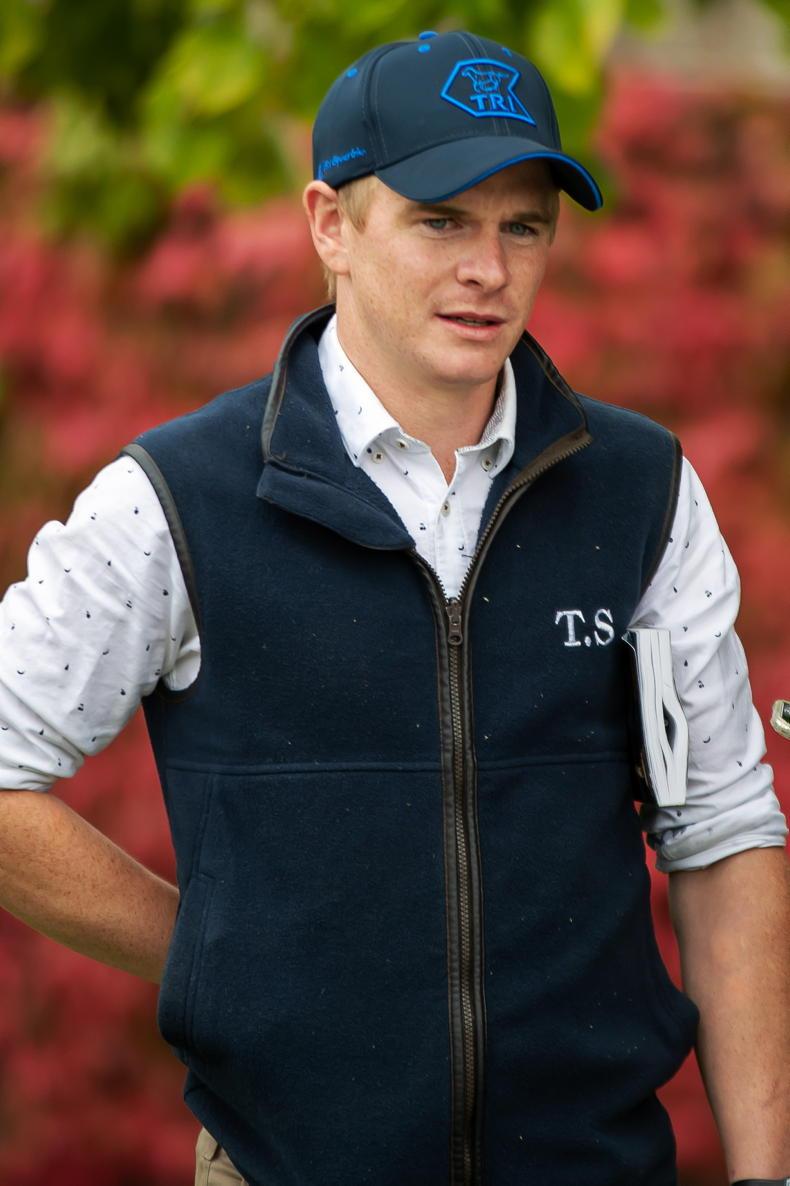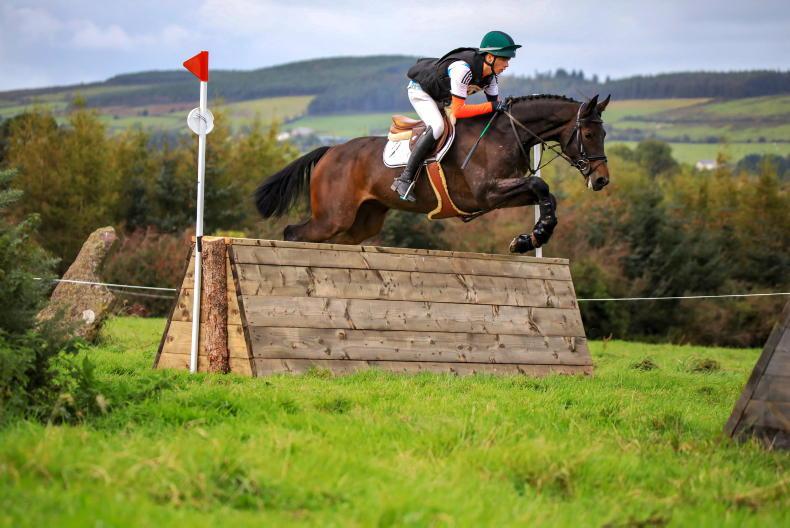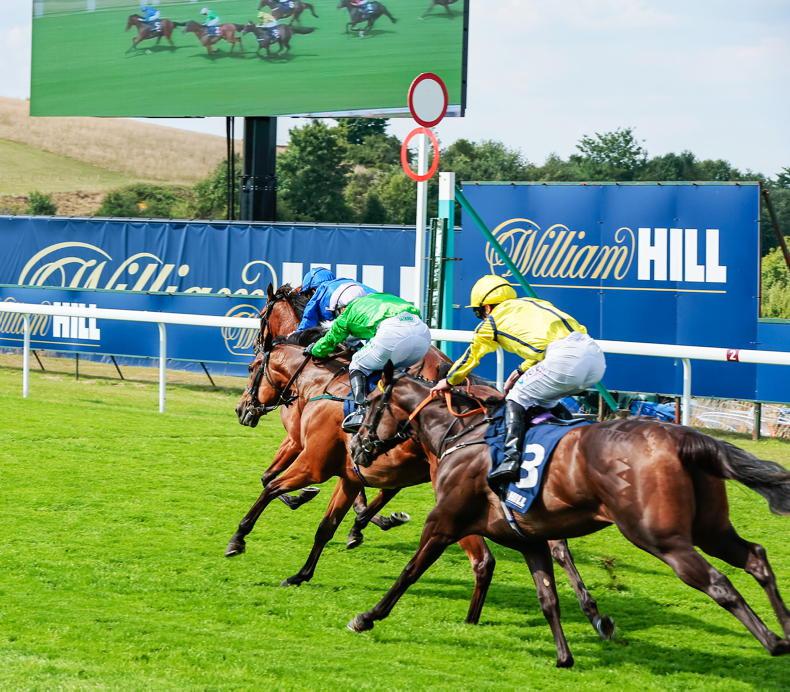SHANE Power told any buyer who would listen to him at the Tattersalls Ireland Goresbridge Breeze-Up Sale in May that he loved his El Kabeir filly, selling as lot 83.
He and his brother Alex, who operate under the Tradewinds Stud banner, bought the filly with a friend of theirs from Cork, Michael O’Brien, at the Goffs Sportsmans Sale last year for €23,000. The pair, based in Clane, Co Kildare, initially come from an eventing background. Indeed Shane has represented Ireland at that discipline at underage European Championship level, but now racing has taken over. O’Brien produced multiple Grade 1 winner Mighty Potter and has since launced a solo career.
The Powers broke this filly in, watched her grow and develop, gradually upped the tempo with her on the gallops. All the time, they liked her more and more.
She sold for €52,000 to go into training with Karl Burke and be named Bright Diamond. It wasn’t a monumental upgrade but for the lads, that wasn’t the most important part. For them, at this stage of their operation, performance on the track trumps price through the sales ring.
Bright Diamond has delivered on everything she showed at Tradewinds and more. She won her Newmarket maiden by nine lengths before finishing third in a Group 3 at Goodwood and then in the same position behind Commissioning in the Group 1 Fillies’ Mile back at Newmarket.
For two guys still in the infancy of their careers in the bloodstock sector, it’s huge. The easy thing to do at Goresbridge would have been to keep quiet, let the horse sell and let her do the talking on the track.
“I suppose it is risky,” Shane Power admitted this week. “But if you do believe in something, maybe you need to push the boat out a little bit. We’re just trying to produce the best horses we can on the track, but it’s nice when you recommend one that goes on to justify it.
“We really liked that filly all along and we said it to everyone at the sales that we thought a lot of her and people remembered that at the yearling sales when they came back around in the last few months. I definitely think it helped a lot with our own reputation this year.
“The most important thing in this business, which probably gets overlooked, is that you have to sell horses that prove it on the track.”
Family home
Shane is the older of the pair at 29 while Alex is 23. The yard and facilities they operate from are adjacent to their family home. It wasn’t a producer of thoroughbred stock until Shane embarked on his own pursuit into the sector. The seeds of that pursuit were sewn when he rode ponies with Robert O’Callaghan at the age of 12.
He became friends with Robert and would then accompany his family’s Yeomanstown team to the races and the sales. An early friendship with Roderic O’Kavanagh at pony club minimus training also led to him spending considerable time at Kildaragh Stud.
In 2016, when he was 21, he did Thoroughbred Breeding Course at the Irish National Stud and then spent time in Arrowfield Stud in Australia. He came back and bought a Champs Elysees filly with a few friends for €9,000, selling her the following year for €65,000. It was then when he realised this was a vocation for him.
Alex’s gravitation into racing is similar as it came via Yeomanstown. What was supposed to be a short stint of part-time work, turned into six years weekend and holiday work at the highly respected stud.
Like his brother, he is an accomplished eventer but now his head has been turned to the racing bloodstock sector, and he will follow in the footsteps of Shane when he leaves for Australia in December, embarking on a six-month stay at Newgate Stud, where he hopes to gain valuable insight.
The Tradewinds operation began as a venture in around 2017 when Shane and Alex, backed up by friends and family, bought three foals at Goffs in the 2017. One of them was by No Nay Never, who had his first runners on the track that year, and gave them a €40,000 profit on their initial €25,000 outlay. Since then their business has progressed each year with the addition of breeze-up horses, National Hunt pre-trainers and yearling consignments for outside clients.
This year was already a major one through the exploits of Bright Diamond but it got even better at the September Yearling Sale at Tattersalls where Tradewinds sold a Due Diligence filly for €78,000, a €72,000 upgrade on her price as a foal, and a Sioux Nation colt who initially cost €7,000 before increasing to €50,000. They also consigned a New Bay colt for a client and he topped the sale at €115,000.
At a relatively very young age, the pair have established a foothold in the sector and done so without a big source of capital to start them off. For any 20-something, they’ve shown it can be done.
“I always had a part-time job and did some other work on the side until fairly recently,” Shane says. “I worked at the sales through the years and I was always trying to pay attention to what people were buying.
“Then you’re just saving up as best you can and then investing as best you can at the end of the year. I don’t think you need a huge amount of capital at the start. It’s an industry where it’s possible to get really lucky with a small initial investment, which does give people a great opportunity to get going.
“The first horse we bought was a Champs Elysees filly for nine grand and we got 65 for her. Of course there is an element of luck in a sale like that, but it gives you confidence that you can do it.
“I think in the beginning, you need to go and look at foals with as many good people as you can, people that know what they’re doing. You educate yourself as best you can and at some point you just have to put yourself out there.
“It can be quite intimidating buying a horse for the first time, but there’s a huge amount of goodwill for young people in this industry who are going in there trying to make a go of it, and it comes from all angles, whether it’s auctioneers, established consigners or sales staff.”
Operating
The lads are currently operating out of 15 stables out the back of the house they grew up in. There is a five-horse walker, a lunge pen and in all, 25 acres of land. There is also a further 30 acres they can rent and they also have access to a three-furlong woodchip gallop.
Mother and father, Niall and Liz, and sister Rachel are always around to help and that is huge. But while these facilities are adequate for their current business, you get the feeling there is a bustling and determined ambition that ultimately outgrow their current base.
“I guess we’ve both been very much influenced by working at Yeomanstown,” Alex says. “I was lucky to get a chance to work there. I suppose two years before I started they had really moved on to an elite level, just as Dark Angel started to get going.
“That sort of money blows your head really doesn’t it? And look, there was no real magic dust put over what they did, it was hard work. It’s a fairly simple way of running it there. If we could be half as successful as what they’ve done, you’d be delighted.”
Shane has already been quoted saying the dream is to have a stallion farm.
“That seems like a long way away at the moment but who knows what will happen,” he says. “I definitely want to keep doing what we’re doing and keep growing every year. It’s not even a case of just getting more money and spending it, I genuinely just want to sell horses that turn out to be good each year.
“That has to be the main priority. The rest of it will fall into line if that is what you are doing. If you are producing a really good product, it shouldn’t be too hard for you to make it profitable. Selling good horses is what keeps bringing people back to the door.”
The business involves several disciplines now and the plan is to keep it that way rather than narrow down and specialise in one area.
“Consigning horses for other people is a great way of establishing relationships and basically working with good horses. The breeze-up side is one we’ve developed recently and the attractive thing for me was firstly we had a skill set where we could ride horses, so we didn’t need to pay anyone to do that and secondly, it’s quite difficult to build a business when you’re only getting a high influx of money for say, two months a year - September and October when you’re selling yearlings - and then you’re reinvesting it a month later.
“Whereas at least with the breeze-ups, the selling takes place in April and May, and that’s a nice stop-gap until the yearling sales come back around.”
Working so closely with family members is an environment that can become intense at various stages of the year surely tests the dynamic of relationships.
“Sure like any good business relationship, there would be rows,” Alex says. “We definitely have two different temperaments. That has good and negative aspects but it seems to be working so far and fingers crossed it continues that way.
“When we go to the sales to buy horses, there’s no pressure on anyone. If someone doesn’t want to buy a foal, we don’t have to be involved together. As the thing has gone on a bit longer, naturally we do end up buying more together.
“I think the big thing in this game is to remember you can only put one foot in front of the other, you have to stay level, because horses will have you on your arse fairly quickly. There is no shortcut.”
Shane picks up from that point: “One day you can be tearing your hair out with a horse and then the next day his half brother wins five lengths in a Newmarket maiden and everything is hunky dory again.
“It’s about trying to stay somewhere in the middle of those two scenarios. If you get too high or low, you just won’t be able to function in this game.
“Even when you’re buying foals, you can spend a whole day at the sales getting blown out of the water on nice foals that you wanted to buy and it can be demoralising sometimes then all of a sudden you wait around and three lots from the end you could end up buying a horse you really wanted.”
Risk and reward
Still, there will always be a certain type of risk and reward in selling thoroughbreds and you get the feeling that is an attractive aspect to those who devote their life to it.
“I wouldn’t say I enjoy that but I can kind of appreciate that it’s like playing golf, your worst shot you’ve ever played can be followed by your best shot you’ve ever hit,” Shane says.
“Sometimes things don’t come together for a horse at a particular sale and then everything falls into place for the next horse and you hit the bullseye. The margins are extremely tight, we just try to keep a level head.
“Whenever you walk into a sales ring to sell a horse, the experience is unique. You’re walking behind your yearling that you’ve put 12 months of work into and it’s all coming down to the next two or three minutes.
“It’s a fairly high-octane game that way. It doesn’t just pay every week. But it does give you quite a rush when you go into the ring and then all of a sudden there’s bids coming from everywhere.
“You just never know beforehand. Three people can follow your horse into the ring and they might have a totally different idea in their head of what you thought the horse is worth. Until someone sticks their hand up and bids, it all hears say.”
The lads still have a Magna Grecia colt and an Iffraaj colt to sell this coming week at the Autumn Yearling Sale at Goffs and then it will be on to the big foal sales at home and in Newmarket as a new cycle begins before Alex heads off for a mini sabbatical in Australia.
“ I just felt it was probably a good time to go, that if I didn’t go now, I’d never go,” he says. “Sure, the idea is to learn as much as I can and hopefully bring something back. I think we’ll be ready to go big time when I get back.”


 This is a subscriber-only article
This is a subscriber-only article
 It looks like you're browsing in private mode
It looks like you're browsing in private mode







SHARING OPTIONS: